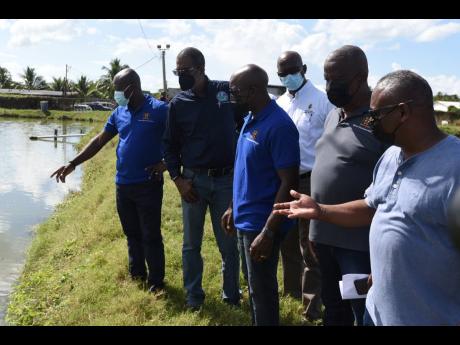Anti-praedial larceny measures taking shape – Charles Jr
Three weeks into his appointment as minister of agriculture and fisheries, Pearnel Charles Jr has signalled that he is making progress in putting in place measures to adequately address the theft of livestock and farm produce, during a recent tour of fish farms in St Catherine.
This assurance comes despite the fact that his predecessors and regional counterparts have failed over the decades to cauterise in any significant way, what the Food and Agriculture Organization (FAO) has described as the most extensive among all crimes committed in the subregion in terms of the number of persons and families affected. On average, 82 per cent of farmers and fishers affected are commercial or semi-commercial producers between the ages of 45 and 50 years.
ESTIMATED LOSS IN THE BILLIONS
In Jamaica, a conservative estimate of the loss to farmers and fishers each year due to the harvest being stolen has been estimated at $6 billion.
In its comprehensive study, ‘An Analysis of the State of Praedial Larceny in Member States of CARICOM’, which was done in collaboration with the Caribbean Disaster Emergency Management Agency, under the umbrella of the Agricultural Sector Disaster Risk Management Committee, the results of which were released in 2013, the FAO noted: “ Policing and programmes to combat praedial larceny have become an integral consideration in how agriculture producers, processors and distributors function in the region in an effort to secure their on-farm investments, and in how policy makers build strategies to secure the economic gains from public investment in the sector.”
While keeping his cards close to his chest, the new agriculture minister, who took office on Janaury 11, made it clear that the scourge of farm theft was receiving priority attention and that progress was being made in dealing with it, during a stop on the second leg of the tour at McLish’s Fish Farm in Nightingale Grove, Bushy Park, last Wednesday.
BEST PRACTICES
“I don’t want to give away too much, but myself and Minister (Frank) Witter are already in discussion with international players who have the innovation and the best practices. We are sitting down with Superintendent (Oral) Pascoe (head of the Praedial Larceny Prevention Unit) and the commissioner of police and his team, to see how we can develop the systems.
“We are going to put in place a network of solutions to make sure that we can protect our farmers; and the warning to the praedial larcenists is, find another occupation. You won’t have a lot of time left to be dabbling in praedial larceny, because we are going to come for you and we’re gonna find you. We gonna work with the farmers, and we gonna make sure that you become convicted and locked up, so that we can grow our sector safely, and get young people and women to feel that this is an area that they can make their investments.”
The FAO study found that offenders operate in a complex social and economic environment, encompassing varied groups of individuals who have developed livelihoods and businesses from the stealing of agriculture produce, equipment and materials. Each group has developed its own dynamics in a distribution chain where the crime enters undetected into the normal processes of legitimate industry of especially domestic fresh food distribution.
“Conservative estimates are that 18 per cent of the value of farm output regionally is taken by thieves, resulting in the loss of millions of United States dollars annually. This does not account for future loss to agriculture production and productivity when farmers leave the sector, or when high-quality, genetic breeds of livestock and crop varieties are stolen from breeding stations and agriculture research facilities and sold as food. Nor does it take into consideration the likely consequences or public health and subsequent industry fallout should tainted, uncertified produce gain entry into the domestic food chain.”

